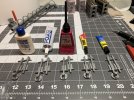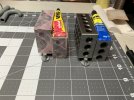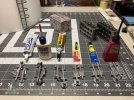POLO_Train
Registered
I have a question for anyone else building PIKO and POLA buildings.
I have and had several 20-year-old POLA buildings where the plastic would break before the glue joints in those models. I perceive it as the glue back then was very strong because it was able to actually plastic weld the crazy plastic LGB and POLA was using at the time. I looked it up at one point and it was a crazy polymer compound that LGB used on its models. I didn't keep up with my hobby for years. 4 years ago I tried to kitbash a giant loco shed with a PIKO brewery kit and PIKO double loco shed where it spanned 5 PIKO building panels on the long side to fit a 24" engine with a shop at the end of it and I used the supplied UHU glue and bought more from the EU when I ran out of UHU glue. I clamped each section as well.
The problem is that the 5-panel section just fell apart under its own weight during transit when I was moving it to my new home. I feel I do not understand something that would cause those glue joints to fail so easily.
Any suggestions between UHU vs PIKO Fix?
I have and had several 20-year-old POLA buildings where the plastic would break before the glue joints in those models. I perceive it as the glue back then was very strong because it was able to actually plastic weld the crazy plastic LGB and POLA was using at the time. I looked it up at one point and it was a crazy polymer compound that LGB used on its models. I didn't keep up with my hobby for years. 4 years ago I tried to kitbash a giant loco shed with a PIKO brewery kit and PIKO double loco shed where it spanned 5 PIKO building panels on the long side to fit a 24" engine with a shop at the end of it and I used the supplied UHU glue and bought more from the EU when I ran out of UHU glue. I clamped each section as well.
The problem is that the 5-panel section just fell apart under its own weight during transit when I was moving it to my new home. I feel I do not understand something that would cause those glue joints to fail so easily.
Any suggestions between UHU vs PIKO Fix?





